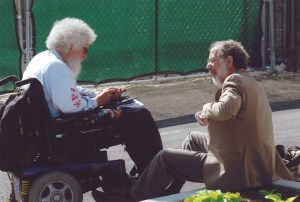
Bob Kafka of ADAPT with civil rights attorney Steve Gold outside of Access Living during a housing conference
Steve Gold is a civil rights attorney based in Philadelphia. He has collaborated and still collaborates with Access Living on disability rights cases, including the pending “Colbert” case that was filed on behalf of people with disabilities in nursing homes in Illinois. Gold issues regular bulletins on disability issues. This bulletin focuses on Medicaid long-term care spending, looking at the break down of institutional spending versue community based spending. Twenty years after the Americans with Disabilities Act, and 11 years after the Olmstead Supreme Court ruling, many states, including Illinois, still disproportionately fund institutional care.
Steve Gold Information Bulletin #321 (8/2010)
Each State’s FY 2009 Medicaid expenditures provide extremely helpful information to analyze your State’s distribution of its Long Term Care expenditures between its Institutional versus Community-Based Services.
Follow the Medicaid money and you’ll see how committed your State really is to ending unnecessary institutionalization of older and younger Americans with disabilities. How your state allocates its expenditures demonstrates its commitment to provide the elderly and younger persons with disabilities a real choice between unnecessary institutionalization and living in the community.
Let’s repeat – “show us the money” and where your state spends it, and you can see how much your state respects both the ADA and the Olmstead decision. Remember that the Supreme Court in 1999 – more than ten years ago -told states to end unnecessary institutionalization! The FY 2009 data was just released by Thomson Reuters, an independent contractor which compiles the data submitted by each State to the federal funding agency.
How much progress has been made? Let’s compare the past five years.
In FY 2004, States spent 74.9% of their total Medicaid LTC funds for “Aged/Disabled” [i.e., older and younger Americans with disabilities] Services in nursing homes, and 25.1% in the community.
In FY 2009, States spent 66.2% of their total Medicaid LTC funds for “Aged/Disabled” Services in nursing homes, and 33.8% in the community.
In dollar terms, in FY 2004, States spent about $46 billion on institutional care and $15 billion in the community. In FY 2009, States spent about $50 billion on institutional care and $26 billion in the community.
The good news is that there was an 8% shift towards the community in those five years. The bad news is that ten years after the Olmstead decision, States are still spending nearly twice the amount of Medicaid LTC funds on nursing homes than on services in the community, despite the overwhelming survey data showing that people want to stay at home.
There is nothing magical about where your State allocates its Medicaid money. Tomorrow States could turn the FY 2009 upside down and spend 66.2% in the community instead of in nursing homes – IF States wanted to do so.
Congress and CMS has given States enormous flexibility during the past five years but most States have not taken advantage of the options.
Why has the change been so slow? State legislatures and Governors seem to be very beholden to the nursing home industry, which definitely knows how to play the political process much better than elderly and disabled advocates.
Until the political pressure from the people with disabilities – regardless of age- increases, the nursing home industry will prevail. Let’s look at how your State did in FY 2009 with its Medicaid Long-Term Care expenditures for older and younger Americans with Disabilities:
Some States have consistently done very poorly and have been consistently below the national average. Some States conversely been consistently above the national average. Some States seem ripe for class action Olmstead litigation.
What sanctions are CMS and OCR planning for those States that have both lengthy waiting lists for community-based services and spend disproportionately on nursing homes?
In the listing below, the first number is the percentage spent on nursing home services. The second number is the percentage spent on community-based services.
National …………………66.2% ………… 33.8%
Alabama ………………….85.1% …………14.9%
Alaska …………………. 44.3% ………….55.7%
Arizona ………………… 78.6%…………..21.4% *
Arkansas………………… 71.0 …………..29.0
California………………. 44.9 …………..55.1*
Colorado………………… 56.4……………43.6
Connecticut……………….75.7……………24.3
Delaware………………….87.5……………12.5
D. C……………………..54.4……………45.6
Florida…………………..79.5……………20.5
Georgia…………………..74.0……………26.0
Hawaii……………………80.8……………19.2*
Idaho…………………….56.7……………43.3
Illinois………………….80.2 …………..19.8
Indiana…………………..83.8 …………..16.2
Iowa……………………..70.4 …………..29.6
Kansas……………………60.6……………39.4
Kentucky………………….80.7 …………..19.3
Louisiana…………………67.5……………32.5
Maine…………………….75.5 …………..24.5
Maryland………………… 85.1……………14.9
Massachusetts…………..64.1……………35.9*
Michigan………………….78.5……………21.5
Minnesota…………………42.5……………57.5*
Mississippi……………….84.2……………15.8
Missouri………………….66.3 …………..33.7
Montana…………………..66.1……………33.9
Nebraska………………….75.1……………24.9
Nevada……………………65.9 …………..34.1
New Hampshire……………..82.3……………17.7
New Jersey………………..78.8……………21.2
New Mexico………………..31.2……………68.8
New York …………………61.9……………38.1*
North Carolina…………….57.2……………42.8
North Dakota…………….. 89.8……………10.2
Ohio……………………..75.9 …………..24.1
Oklahoma………………… 67.6……………32.4
Oregon………………….. 43.8……………56.2
Pennsylvania…………….. 82.1……………17.9
Rhode Island…………….. 95.6…………….4.4*
South Carolina…………… 72.1……………27.9
South Dakota…………….. 86.0……………14.0
Tennessee……………….. 91.1…………….8.9*
Texas…………………….55.5……………44.5*
Utah……………………..80.4……………19.6
Vermont…………………..67.5……………32.5*
Virginia………………….64.9……………35.1
Washington ……………….38.0 …………..62.0
West Virginia……………. 74.5……………25.5
Wisconsin ………………. 74.0 …………. 26.0*
Wyoming ………………….76.6……………23.4
* Data may not include certain LTC expenditures with managed care or 115 waiver data not available.
Steve Gold, The Disability Odyssey continues
To learn more about Steve Gold or subscribe to his mailing list, click here






